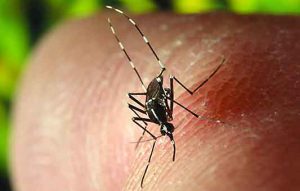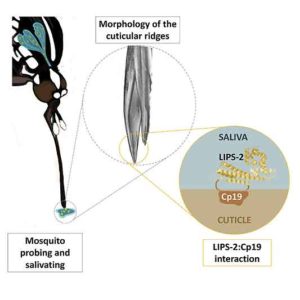
Zanzara tigre – Aedes albopictus
Researchers discovered how mosquitoes penetrate the skin to reach the blood vessels, the mechanism that allows mosquitoes to stiffen their stingers to suck blood.
The mosquito proboscis is an efficient microelectromechanical system that enables the insect to feed on vertebrate blood quickly and painlessly.
Its efficiency is further enhanced by the insect’s saliva, albeit through hitherto unclear mechanisms.
The researchers identified a protein in the saliva of Aedes mosquitoes that they named LIPS, which stands for “labrum-interacting protein of the saliva,” says Paolo Gabrieli, of the Laboratory of Entomology and Parasitology at the University of Milan.
“Next, we identified the receptor responsible-a discovery essential for developing effective strategies to interfere with this mechanism and thus reduce or prevent mosquitoes from biting us, says Federico Forneris, head of the Armenise-Harvard laboratory at the University of Pavia.
 We have demonstrated the functioning of this mechanism by “turning off” the gene that produces LIPS, resulting in mosquitoes that are no longer able to sting humans.”
We have demonstrated the functioning of this mechanism by “turning off” the gene that produces LIPS, resulting in mosquitoes that are no longer able to sting humans.”
The research then proceeded further to determine the structure of the protein, discovering a previously unobserved organization that could be the trojan horse for developing substances to be used as future mosquito deterrents.
First authors and main investigators of the experimental work are two Ph.D. students from the Armenise-Harvard laboratory in Pavia: Irene Arnoldi, from Bergamo, and Giulia Mancini, from Sulmona, whose motivation and perseverance made it possible to obtain the important results under the guidance of Gabrieli and Forneris, respectively. The infrastructural contribution from the Great Instruments Center of the University of Pavia was essential.
The study, published in Current Biology, is the result of a collaboration between the University of Pavia and the University of Milan and was developed thanks to support from the Armenise-Harvard Foundation, the Cariplo Foundation, a ministerial “PRIN” project reserved for young researchers and NATO through the “Science for Peace and Security” program.
For more information
Current Biology
A salivary factor binds a cuticular protein and modulates biting by inducing morphological changes in the mosquito labrum
Link…
UNIVERSITA’ DEGLI STUDI DI MILANO
Dipartimento di Bioscienze
Link…
https://www.dbs.unimi.it/ecm/home
UNIVERSITA’ DI PAVIA
Dipartimento di Biologia e Biotecnologie “Lazzaro Spallanzani”
Link…
Fondazione Armenise-Harvard
Link…
MDN
This post is also available in:
 Italian
Italian


